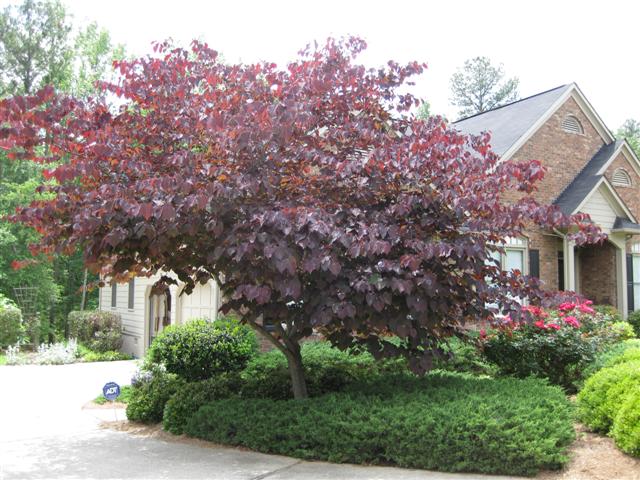Georgia Gardener Newsletter Cool Plant: August 9, 2007
| Forest Pansy Redbud |
| Cercis canadensis 'Forest Pansy' |
Species Native Range: Eastern half of the U.S.
Hardiness: USDA Zones 6-9
Mature Size: 15-20 feet tall and 15 feet wide
Exposure: Full sun to light shade
Soil: Well-drained soil
Ease of Culture: Easy
Although not blooming at this time of year, the Forest Pansy Redbud is still an attractive tree in the landscape.
After the purple (not red) flowers appear in the very early spring, the leaves emerge a reddish-purple which they
will hold all season if in full sun. In light to partial shade, the leaves will fade a bit to green during the summer.
The Eastern Redbud is a member of the legume (bean) family and is covered with odd looking bean pods by fall. Because it's
related to beans, it's able to fix nitrogen from the atmosphere and convert it into usable soil nitrogen. Without
getting into a complex discussion of biochemistry, this means that the Eastern Redbud is able to tolerate soils
poor in nutrients. It does, however, enjoy good drainage. Wild stands of Redbuds also usually indicate the presence
of limestone. Although tolerant of a wide range of soil pH, you may find that your Redbud is happier
if given lime once a year.
Grow Forest Pansy Redbud in full sun to light shade. Flowering and foliage color will be better in the sun. Good
companion plants include Loropetalum (for an additional blast of purple), Gold Mop False Cypress, yellow Daylilies,
Iceplant, etc.
Note: Fall is the best time to plant trees and shrubs. Even though I'm featuring this plant now, I would wait until
late September or October to plant.
Sources
This tree is widely available at retail nurseries.
Copyright © 2007 by Theresa Schrum - All rights reserved
No part of this website may be reproduced without the expressed written permission of Theresa Schrum

